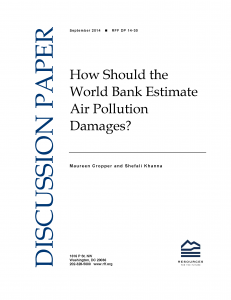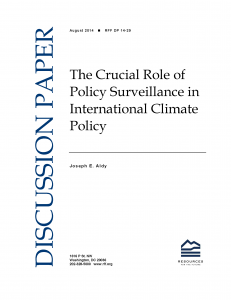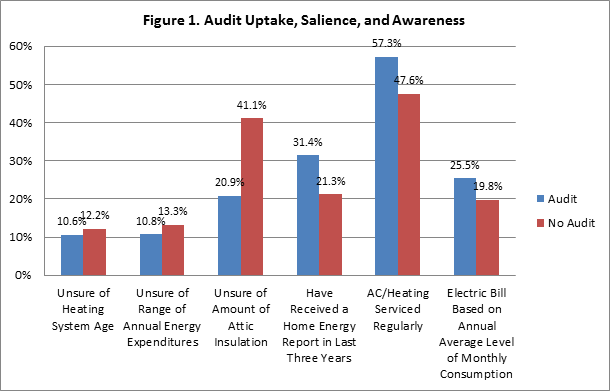How Should the World Bank Estimate Air Pollution Damages?
 One of the indicators the World Bank uses to measure the sustainability of a country’s growth is adjusted net savings (ANS), which includes an estimate of the costs of health damages from exposure to outdoor air pollution. This pollution damage indicator is published annually in the World Development Indicators, together with estimates of annual average PM10 (particulate matter less than 10 microns in diameter) in cities of 100,000 or more. Estimates of health damages associated with PM10 exposure are the monetized value of Disability-Adjusted Life Years (DALYs) associated with PM10 exposure in these cities, expressed as a percent of each country’s gross national income (GNI).
One of the indicators the World Bank uses to measure the sustainability of a country’s growth is adjusted net savings (ANS), which includes an estimate of the costs of health damages from exposure to outdoor air pollution. This pollution damage indicator is published annually in the World Development Indicators, together with estimates of annual average PM10 (particulate matter less than 10 microns in diameter) in cities of 100,000 or more. Estimates of health damages associated with PM10 exposure are the monetized value of Disability-Adjusted Life Years (DALYs) associated with PM10 exposure in these cities, expressed as a percent of each country’s gross national income (GNI).
In a new RFF discussion paper, commissioned by the World Bank, we review the current methodology for estimating the cost of air pollution damages and identify better data sources to enable more accurate estimates of pollution exposure and health costs. We note two shortcomings to the current approach to modeling exposure to outdoor air pollution. The first problem is that current estimates ignore the approximately 5 billion people who live outside cities of 100,000 or more. Although, historically, outdoor air pollution has been considered an urban problem, a comparison of the 2010 Global Burden of Disease (GBD) and World Bank estimates suggests that half of deaths due to outdoor air pollution occur in rural areas. Read More
Pursuing a Global Climate Treaty: Next Stop, New York
Climate change takes center stage in New York City two weeks from now when world leaders will attend the United Nations Climate Summit—a stepping stone along the path to a new global climate agreement to emerge in Paris in late 2015. Don’t expect a “kumbaya” moment at the summit. Rather, expect to see a very public display of country negotiating positions and an equally public display of reaction to those positions.
Summit organizers hope these leaders will unveil commitments to aggressively reduce future greenhouse gas emissions—commitments that would become the foundation for a new, legally binding Paris agreement. However, reflecting the ongoing international negotiations running up to Paris, one can expect each leader’s commitments to be vague, but also to see considerable specificity about the legally binding nature of the agreement. The European Union is advocating for an agreement whereby commitments would be binding under international law (a treaty), while the United States argues for legally binding domestic commitments absent a new treaty. Read More
Ecosystem Services in the Southern Appalachian Mountains
In 1990, the Acid Rain Program introduced market-based environmental policy on the largest scale ever attempted. The program capped the total level of acid rain–causing sulfur dioxide emissions from the US electricity sector and allowed utilities to trade under that fixed cap—a so-called cap-and-trade system. Ironically, though much of the original motivation for that program was, as indicated by the name, to reduce acid precipitation, economic assessments of the program have largely focused on health benefits, rather than the ecosystem services stemming from a reduction in acidification. That trend has continued with evaluations of more recent EPA regulations.
In a new RFF discussion paper, “Valuation of Ecosystem Services in the Southern Appalachian Mountains,” RFF colleagues Dallas Burtraw, Alan Krupnick, and Juha Siikamäki and I, along with Susie Chung Criscimagna of Eden Housing, Bernard Cosby of the University of Virginia, and David Evans of EPA, estimate the monetary value of reducing acidity in the southern Appalachian region. Our estimates were based on the stated preference method, which allowed us to survey households about their willingness to pay (WTP) for the restoration of ecosystem services in the region. Based on their answers, we determined that households across the region would be willing to pay $15.67 per year each—or about $208 million in total—to restore the environment of the southern Appalachians to a healthy state. Aggregated and discounted into the future, and allowing for a 50-year delay for the ecosystems to recover, these annual values come to a present value of $3.7 billion. Yet it’s worth noting that these ecosystem service benefits still pale in comparison to the total economic benefits of reducing air pollution, which stem overwhelmingly from public health.
Using two versions of the stated preference method to survey participants allowed us to discern and rank relative household interest in potential policies, resulting in an approach that valued wholesale ecosystem changes as well as the individual values of ecological policy attributes. This was achieved by combining a dichotomous choice contingent valuation (in which respondents vote for or against policies) and a choice experiment (in which preferred programs are selected from a group of options), both of which were linked to detailed ecosystem models that incorporated regional aquatic, terrestrial, and animal characteristics. By gathering information on both individual and holistic policy preferences, our results better support the benefit-cost analysis of multidimensional environmental policies that require some regulations to be traded off or prioritized over others.
Employing a model that gauges the public’s WTP for environmental goods can also bolster conservation fundraising efforts, as marketing that targets public payments often benefits from information on how much potential donors are willing to contributed for the restoration of individual services. Our approach ultimately offers social scientists and economists the opportunity to use the estimates we generated to evaluate other policy scenarios; although high costs prevent economic studies from being performed for every option, benefit transfers offer a systematic way to reuse information in different situational contexts. This potential for data recycling is a valuable tool for policymakers evaluating strategies for multidimensional ecosystems—especially those that require informed regulations tailored to their individual needs.
The Importance of Reviewing Mitigation Contributions in International Climate Policy
 As the international community continues climate negotiations on the road to the Paris 2015 UN-sponsored climate talks, attention has turned to the review of countries’ emissions mitigation contributions and commitments. This builds on the evolution toward a pledge and review regime established in the 2009 Copenhagen and 2010 Cancun negotiations.
As the international community continues climate negotiations on the road to the Paris 2015 UN-sponsored climate talks, attention has turned to the review of countries’ emissions mitigation contributions and commitments. This builds on the evolution toward a pledge and review regime established in the 2009 Copenhagen and 2010 Cancun negotiations.
In my new RFF discussion paper, “The Crucial Role of Policy Surveillance in International Climate Policy,” I note how information-creating mechanisms—such as reviews—can enhance the transparency of and can support participation and compliance in international agreements. Drawing from game theory, international relations, and legal scholarship, I argue that through transparent policy surveillance, negotiators can make possible a more effective international climate change policy architecture.
This Week in the RFF Library Blog
Each week, we review the papers, studies, reports, and briefings posted at the “indispensable” RFF Library Blog, curated by RFF Librarian Chris Clotworthy.
The Department of Energy has developed this biennial report to Congress in compliance with legislative language set forth in Section 1302 of the Energy Independence and Security Act of 2007. This report is designed to provide an update on the status of smart grid deployments nationwide, technological developments, and barriers that may affect the continued adoption of the technology. The report has been reviewed by the Federal Smart Grid Task Force, a group of 11 agencies, chaired by DOE, that meets to coordinate federal smart grid activities and includes representatives from the National Institute of Standards and Technology (NIST), the Federal Energy Regulatory Commission (FERC), and the U.S. Department of Homeland Security. – via US DOE
[From Blog Post] …In the 20 countries with the largest shale gas and tight oil resources, WRI analyzed the level of water stress across every play in each country. For shale gas, we found plays in 40 percent of those countries face high water stress or arid conditions: China, Algeria, Mexico, South Africa, Libya, Pakistan, Egypt, and India. – via World Resources Institute
Technological advances such as hydraulic fracturing and horizontal drilling are driving the increase in oil and natural gas extraction and allowing access to shale resources in Canada and the U.S. that were previously uneconomical to develop. In fact, the United States became the No. 1 producer of oil in the world in 2014—overtaking Saudi Arabia and Russia. The U.S. produced 8.4 million barrels per day of oil in April 2014, which is the highest monthly production volume in more than 25 years—with North Dakota and Texas supplying almost half of the total U.S. crude oil production. The rapid expansion of crude oil production in North America has increased the use of rail, truck, barge and pipeline to carry crude to refineries. – via National Conference of State Legislatures
Environmentally Friendly Solutions Needed to Recycle Fracking Wastewater: Rice Univ. Study
[Press Release] Rice University scientists have performed a detailed analysis of water produced by hydraulic fracturing (aka fracking) of three gas reservoirs and suggested environmentally friendly remedies are needed to treat and reuse it. More advanced recycling rather than disposal of produced water pumped back out of wells could calm fears of accidental spillage and save millions of gallons of fresh water a year, said Rice chemist Andrew Barron… – via Environmental Science: Processes & Impacts (free download with registration)
Policy Assessment for the Review of the Ozone NAAQS, Final Report
[Green Car Congress] The staff of the US Environmental Protection Agency’s (EPA) Office of Air Quality Planning and Standards (OAQPS) has released the final version of the policy assessment (PA) for the review of the ozone (O3) National Ambient Air Quality Standards (NAAQS). Among the staff recommendations are to further reduce the primary ozone standard from the current 75 ppb (parts per billion) to a revised level within the range of 70 ppb to 60 ppb—and preferably below 70 ppb… – via US EPA
Emission Rate vs. Mass Goals in EPA’s Clean Power Plan
This is the second in a series of questions that highlights RFF’s Expert Forum on EPA’s Clean Power Plan. Readers are invited to submit their own comments to the questions and/or the responses using the “Leave a Comment” box below. See all of the questions to date here.
RFF asks the experts: Who should translate the states’ assigned rate-based goals into mass-based goals—the states or EPA—and how?
EPA’s Clean Power Plan assigns each state an emissions rate goal, in pounds of carbon dioxide (CO2) per megawatt hour (MWh), but also gives states an option to translate this goal into a mass-based goal, in pounds of CO2. Ten states already have carbon trading programs with mass-based caps, and advocates of this approach argue it would have advantages. However, the methodology for translation remains a source of confusion. EPA could eliminate this confusion by presumptively translating the goals into mass-based goals or, instead, providing further guidance to states on how to translate their rate-based goals to ensure consistency in methods, assumptions, and outcomes.
Who should translate EPA’s assigned rate-based goals into mass-based goals, and how?
 “EPA should translate its rate-based goals into mass-based goals. A single standardized method for translation written by EPA would clear up confusion and remove the inevitability of goal inflation if states do the translations themselves.”
“EPA should translate its rate-based goals into mass-based goals. A single standardized method for translation written by EPA would clear up confusion and remove the inevitability of goal inflation if states do the translations themselves.”
—Anthony Paul, Center Fellow, Center for Climate and Electricity Policy, Resources for the Future (See full response.)
 “It would be beneficial for EPA to clarify both (a) the proposed methodology for converting from rate- to mass-based goals and (b) the result of applying the methodology to calculate mass-based state goals, subject to a public notice and comment period.”
“It would be beneficial for EPA to clarify both (a) the proposed methodology for converting from rate- to mass-based goals and (b) the result of applying the methodology to calculate mass-based state goals, subject to a public notice and comment period.”
—Jennifer Macedonia, Senior Advisor, Bipartisan Policy Center (See full response.)
 “Although EPA recognizes the benefits of market-based mass emissions programs, there are many questions that it will need to address to support the use of mass emissions targets for 111(d) compliance…. EPA must provide that clarity in a way that does not penalize early movers.”
“Although EPA recognizes the benefits of market-based mass emissions programs, there are many questions that it will need to address to support the use of mass emissions targets for 111(d) compliance…. EPA must provide that clarity in a way that does not penalize early movers.”
—David Littell, Commissioner, Maine Public Utilities Commission (See full response.)
 “The agency should assist states with translating the plan’s rate-based goal to a mass-based goal by providing a presumptive translation for all states or simply providing standardized guidance on the analytical tools and assumptions needed for making the conversion. The point is to start the conversation for states and regions to utilize all of the cost saving, flexible options a mass-based standard can offer.”
“The agency should assist states with translating the plan’s rate-based goal to a mass-based goal by providing a presumptive translation for all states or simply providing standardized guidance on the analytical tools and assumptions needed for making the conversion. The point is to start the conversation for states and regions to utilize all of the cost saving, flexible options a mass-based standard can offer.”
—Tom Lawler, Washington, DC Representative, International Emissions Trading Association (See full response.)
Please share your own thoughts on this topic below.
Introducing RFF’s Expert Forum on EPA’s Clean Power Plan
This is the first in a series of questions that highlights RFF’s Expert Forum on EPA’s Clean Power Plan. Readers are invited to submit their own comments to the questions and/or the responses using the “Leave a Comment” box below. See all of the questions to date here.
RFF asks the experts: What is the definition of the “best system of emission reduction”?
The proposed Clean Power Plan originates from the US Environmental Protection Agency’s (EPA) authority under Section 111(d) of the Clean Air Act to require states to submit plans that establish and implement a standard of performance achievable through “application of the best system of emission reduction.” EPA chose to interpret the word “system” to encompass: (1) emissions rate reductions at coal plants, (2) shifting generation from coal to natural gas, (3) increasing generation from renewables, and (4) improving end use energy efficiency. A central issue in the environmental effectiveness and legal defensibility of the Clean Power Plan is whether this definition of “system” is within EPA’s statutory authority. EPA views the system as the network infrastructure that delivers electricity services to consumers, but others might hold that a system includes only technical operation of emitting plants.
What guidance can experts give to EPA on this issue?
 “Given the lack of guidance in the statute and deference shown to agency’s interpretation of statutory ambiguity, I think EPA’s interpretation of ‘best system of emission reduction’ is likely to survive legal challenge, with two caveats.”
“Given the lack of guidance in the statute and deference shown to agency’s interpretation of statutory ambiguity, I think EPA’s interpretation of ‘best system of emission reduction’ is likely to survive legal challenge, with two caveats.”
—Nathan Richardson, Assistant Professor, University of South Carolina School of Law (See full response.)

 “The phrase ‘best system of emission reduction’ plainly points toward a broad approach to cutting emissions. . . . [It] can certainly encompass all the techniques available at reasonable cost for reducing carbon pollution at power plants, not just end-of-pipe controls.”
“The phrase ‘best system of emission reduction’ plainly points toward a broad approach to cutting emissions. . . . [It] can certainly encompass all the techniques available at reasonable cost for reducing carbon pollution at power plants, not just end-of-pipe controls.”
—David Doniger, Director, Climate & Clean Air Program; and Benjamin Longstreth, Senior Attorney, Natural Resources Defense Council (See full response.)
 “[A] standard of performance must be based on ‘the application of the best system of emission reduction.’ In this case, the question is ‘the application of the system to what?’ EPA says, ‘to anything that produces or uses electricity.’ But the answer, according to the statute and almost 40 years of regulatory history, is ‘the type of facility being regulated.’
“[A] standard of performance must be based on ‘the application of the best system of emission reduction.’ In this case, the question is ‘the application of the system to what?’ EPA says, ‘to anything that produces or uses electricity.’ But the answer, according to the statute and almost 40 years of regulatory history, is ‘the type of facility being regulated.’
—Jeffrey Holmstead, Partner, Bracewell & Giuliani (See full response.)
Please share your own thoughts on this topic below.
Salience, Attentiveness, and the Decision to Have a Home Energy Audit
This is the third and final post in a blog series on our survey of homeowners as part of RFF’s Energy Efficiency Information Initiative.
 In two earlier blog posts, we summarized some findings from our recent survey on home energy audits. In the first post, we described what we learned about the features of audits and what they cost. In the second, we reported the extent of follow-up on audit recommendations. In this post, we explore some factors that seem to be associated with audit uptake.
In two earlier blog posts, we summarized some findings from our recent survey on home energy audits. In the first post, we described what we learned about the features of audits and what they cost. In the second, we reported the extent of follow-up on audit recommendations. In this post, we explore some factors that seem to be associated with audit uptake.
As economists, we like to think that, by and large, people make decisions based on a rational accounting of costs and benefits. In the case of home energy audits, homeowners are paying for information that should allow them to make better energy investment decisions. And so if the benefits of that information outweigh the costs of acquiring it, we would expect them to spend the money for an audit. But recent research on behavior and energy efficiency suggests that many other factors come into play in people’s decisions about energy use and related investments in appliances, equipment, and buildings. The salience of energy costs and attentiveness to energy usage are two important factors identified by many researchers. In a recent paper, Katrina Jessoe and Dave Rapson show that simple information feedback to households can dramatically increase the price elasticity of demand for electricity. In an experiment the authors conducted, using information along with price increases was much more effective than prices alone. Studies have shown evidence of salience and attentiveness affecting other consumer choices as well. Examples include how sales taxes affect purchase behavior, the effects of repeated information on bank overdraft fees in reducing overdrafts, and the impacts of reminders on gym usage.
This Week in the RFF Library Blog
Each week, we review the papers, studies, reports, and briefings posted at the “indispensable” RFF Library Blog, curated by RFF Librarian Chris Clotworthy.
Regulatory Impact Analysis: Development of Social Cost of Carbon Estimates
To develop the 2010 and 2013 social cost of carbon estimates, the Office of Management and Budget (OMB) and Council of Economic Advisers convened and led an informal interagency working group in which four other offices from the Executive Office of the President (EOP) and six federal agencies participated. Participating agencies were the Environmental Protection Agency (EPA) and the Departments of Agriculture, Commerce, Energy, Transportation (DOT), and the Treasury… – via US Government Accountability Office
Up in Flames: U.S. Shale Oil Boom Comes at Expense of Wasted Natural Gas, Increased Carbon Dioxide
In a new investigation of flaring of natural gas in the nation’s two most prolific shale oil formations, North Dakota’s Bakken Shale and Texas’ Eagle Ford Shale, Earthworks found that North Dakota oil companies have flared more than $854 million of natural gas since 2010, and state officials do not track how much money companies owe in taxes for the gas. The report found that Texas does not tax flared gas at all, pointing to the need for more stringent measures to reduce flaring in both formations and raising questions about whether North Dakota officials will enforce recently issued regulations to control flaring… – via Earthworks
Terminating Links between Emissions Trading Programs
 In the absence of a coordinated global emissions market, a number of self-contained regional carbon-trading programs have formed that independently establish, track, and cancel their own compliance permits. In order to increase the cost-effectiveness, liquidity, and stability of these markets, the entities that control them may choose to link programs together in a framework that allows permits to be unilaterally or bilaterally accepted across joined systems.
In the absence of a coordinated global emissions market, a number of self-contained regional carbon-trading programs have formed that independently establish, track, and cancel their own compliance permits. In order to increase the cost-effectiveness, liquidity, and stability of these markets, the entities that control them may choose to link programs together in a framework that allows permits to be unilaterally or bilaterally accepted across joined systems.
Conversely, these programs can also be severed from one another and dismantled. New Jersey delinked from RGGI and ended its state carbon compliance in 2011, and Australia’s new government recently abolished its carbon pricing program even before it could be linked with the EU’s Emissions Trading System. The termination of links between regional carbon markets—as well as the possibility that a program will be delinked in the future—can have significant impacts on their performance, especially when permits from these programs are banked for use toward future compliance obligations. Read More

 Subscribe; to our RSS Feed
Subscribe; to our RSS Feed Tweets by @RFF_org
Tweets by @RFF_org 
Recent Comments